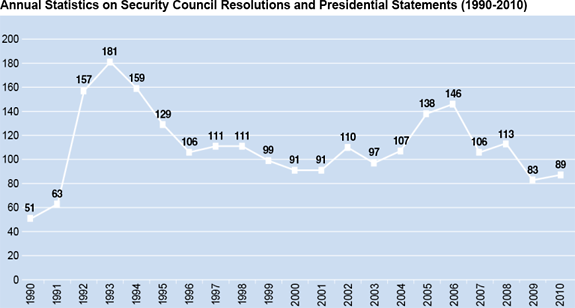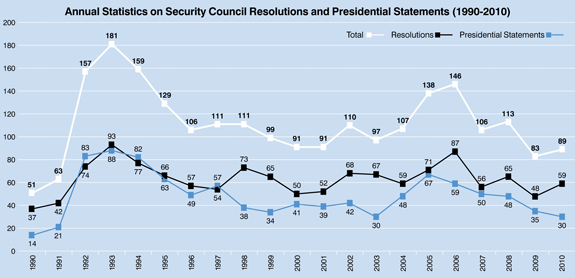Security Council Statistics in 2010
Summary
The year 2010 saw a slight reversal in the previous downward trend in the numbers of Security Council decisions. (The 2009 output was at the lowest level since 1991.) The number of formal decisions increased slightly in 2010 from 83 to 89, however, overall the level remains low. (Please see the chart below.)

Council Decisions in 2010
In 2010 the total number of Council decisions (resolutions and presidential statements) increased by 7 percent from 2009 (from 83 to 89). (The 2009 total represented the lowest level in almost two decades.) Overall, the Council decisions in 2010 are still largely in line with the 2009 level and recent trends.
However, when one breaks down the 2010 figures, a more interesting picture emerges. In 2010, the number of resolutions actually increased quite significantly from 48 to 59 (22 percent). Over half of the increase in resolutions can be accounted for by an increase in the number of resolutions on Côte d’Ivoire (seven as opposed to three in 2009) and Iraq (four as opposed to two in 2009).
By contrast, presidential statements dropped from 35 to thirty. Most of this change can be attributed to a reduction in the number of presidential statements condemning specific terrorist incidents (none in 2010, down from four in 2009. It seems that this reflects a new practice to issue press statements on specific terrorist incidents rather than adopting formal decisions.)

Council Activity
The modest increase in Council decisions is matched by a slight increase in the number of formal Council meetings. The number of meetings grew by 8 percent, from 194 to 210. While the level of change of formal meetings is minor, some notable variations in specific cases can be seen in the numbers of meetings on:
- Iraq (up from seven to 12);
- Cote d’Ivoire (up from 11 to 15); and
- Georgia (down from four to none).
Council decisions on thematic issues remained nearly constant. The number of thematic resolutions increased by one from 10 to 11, and the number of presidential statements on thematic issues remained at 11.
The number of resolutions on counter-terrorism was unchanged. As was the case in 2009, in 2010 only one resolution was adopted. (The 2010 resolution renewed the mandate of the Counter-Terrorism Committee Executive Directorate.) Also, a presidential statement was adopted at the conclusion of the thematic debate on terrorism held under Turkey’s Council presidency in September.
Six resolutions were passed relating to the International Criminal Tribunals for the former Yugoslavia and Rwanda, as opposed to four in 2009.
Use of the veto can potentially negatively impact the number of Council resolutions adopted. However, this has not been the case in the last several years. (No vetoes occurred in 2010 and there was only one veto in 2009.)
In terms of Council activity at the informal level, the number of press statements significantly increased by 47 percent, from 36 to 53. Over half of the increase can be accounted for by eight statements on Côte d’Ivoire (as opposed to none in 2009) and two statements dealing with the January earthquake in Haiti.
There were nine press statements responding to specific terrorist incidents in 2010, down from 10 in 2009.
Appearances of Media Stakeout
Appearances of the Council President and other Council members at the media stakeout also offer some insights into the level and focus of informal work of the Council members. Also, as we noted in our September 2010 brief on Security Council Statistics, questions have arisen regarding transparency and the ongoing level of information via the media stakeout sharing since the relocation of the Council in April 2010 to new temporary premises.
In a September brief we identified a notable reduction in Council media stakeout appearances for the months April-July 2010.
This trend seems to have continued through the end of 2010. Stakeout appearances by the president in August-December 2010 declined by 16 percent (from 48 to 40) when compared with the average number of stakeout appearances for those same months in 2006-2009.
The reduction in stakeout appearances by other Council members is even more pronounced, with a 76 percent drop (from 89 to 21) for the months of August-December. This decline can be partially explained by limitations imposed by the move to temporary facilities. However, there is a risk that, since these temporary arrangements will be in place for several years, the decline in information sharing may become institutionalised.
|
2010: Month – President |
By the President |
By other members |
|
August – Russia |
8 |
2 |
|
September – Turkey |
7 |
5 |
|
October – Uganda |
6 |
3 |
|
November – UK |
9 |
8 |
|
December – US |
10 |
3 |
|
2009: Month – President |
By the President |
By other members |
|
August – UK |
7 |
4 |
|
September – US |
8 |
2 |
|
October – Vietnam |
9 |
6 |
|
November – Austria |
9 |
4 |
|
December – Burkina Faso |
6 |
12 |
|
2008: Month – President |
By the President |
By other members |
|
August – Belgium |
12 |
31 |
|
September – Burkina Faso |
9 |
26 |
|
October – China |
4 |
6 |
|
November – Costa Rica |
9 |
8 |
|
December – Croatia |
9 |
23 |
|
2007: Month – President |
By the President |
By other members |
|
August – Congo |
7 |
15 |
|
September – France |
5 |
15 |
|
October – Ghana |
8 |
26 |
|
November – Indonesia |
10 |
10 |
|
December – Italy |
13 |
20 |
|
2006: Month – President |
By the President |
By other members |
|
August – Ghana |
20 |
32 |
|
September – Greece |
9 |
14 |
|
October – Japan |
21 |
58 |
|
November – Peru |
6 |
24 |
|
December – Qatar |
11 |
22 |
Analysis
When considering possible factors that might have contributed to the present level of Council activity, it is important to note that quantitative benchmarks do not provide a real picture of the Council’s activity, productivity and effectiveness.
It is unclear if the slight increase seen over the past year is only temporary with further statistical decline yet to come. It may be that the two periods of most intense activity following the end of the Cold War, from 1992 to 1995 and 2005 to 2006, were unusual periods with aberrant levels of activity. However, at this time it is impossible to judge this with certainty.
It is also important to note that heightened activity does not necessarily equal increased achievement, and the adoption of a lower number of presidential statements does not necessarily indicate reduced effort on the part of the Council or less positive outcomes. Some proponents of Council reform have advocated a reduction in the number of formal decisions, or at least the time involved in negotiating and adopting them, in order to increase effectiveness in the areas such as conflict prevention and peacebuilding.
Anecdotal comments made by Council members over the past year indicate that members do not consider their workloads to be significantly less than in years past. Indeed, some feel the Council is busier than ever and that there are many key issues that the Council should be involved in but is not even discussing.
Another factor that needs to be borne in mind is that currently Council members now invest much time and energy in meetings at the expert level and in working groups. These activities are less easily tracked than formal meetings. In addition, sometimes a great deal of effort is expended on the negotiation of a single decision. (An excellent example is resolution 1966 on a new residual mechanism to replace the ICTY and ICTR. The report of the chair of the Informal Working Group on International Tribunals [S/2010/684] detailed the long and arduous series of meetings which led up to the final decision.)
There is growing concern that the Council is too reactive to events, rather than engaging proactively with emerging concerns. Some feel this has led at times in the past to the “hyperactive” adoption of decisions that focus more on short-term symptoms than underlying causes and sometimes add little value. It may be that this sentiment has to some extent influenced Council decision making in the last two years. New processes to help address international threats more proactively began in 2010, with the Council participating in a “horizon scanning” briefing in November under the UK presidency and another in January 2011 under the Bosnia and Herzegovina presidency.
As to the underlying level of “demand” for Council activity, it is interesting to note the conclusions of the 2010 Human Security Report. It concludes that the number of armed conflicts has not been decreasing and in fact has been growing. However, most of the increase is in smaller conflicts that result in relatively few deaths than in earlier times.
Other Possible Contributing Factors
A number of possible contributing factors to the downward trend were identified in our 2009 report on Council statistics. One was the impact of the global financial crisis, which had led governments to necessarily expend much energy on economic and financial issues, perhaps at the expense of security initiatives in the Council. This has probably had an impact throughout 2010 as well. Moreover, most foreign ministries have continued to be under great pressure to reduce costs. This has almost certainly also continued to dampen initiatives.
Overall, the atmosphere in the Council seems to have been constructive during 2010. Dynamics between the members were basically very positive and are unlikely to have negatively affected statistics. Some contention was apparent around the negotiation of the sanctions resolution on Iran. However, it did not have an obvious impact on the Council’s ability to advance work on other issues.
Full forecast
